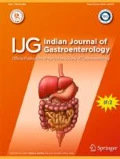Abstract
Aims and Objectives
The aim of this study is to compare surface pH in various parts of the oral cavity between patients with gastroesophageal reflux disease (GERD) and healthy controls.
Methods
Using a flat pH meter sensor, fixed electrode pen type digital pH meter, oral pH levels were assessed at different mucosal sites among 34 GERD patients and 32 healthy controls. Salivary flow rates and buffering capacity were also assessed in them. A thorough oral examination was performed to screen for any oral and dental changes.
Result
A significantly lower pH of 6.65 ± 0.13 (mean ± SD) was found in the GERD group compared to control group 7.23 ± 0.12 (p < 0.05). Least pH was found in the floor of the mouth 6.594 ± 0.17 and highest in the lower labial mucosa among the GERD patients. Salivary flow rate and buffering capacity were low in these patients. Significant changes were noticed in the hard and soft tissues of the oral cavity among the GERD group.
Conclusion
Oral mucosal pH is altered in GERD patients and may contribute to effects on the oral cavity.
Similar content being viewed by others
References
Deschner WK, Benjamin SB. Extraesophageal manifestations of gastroesophageal reflux disease. Am J Gastroenterol. 1989;84:1–5.
Cazzonatto H Jr, Bernasconi GCR, Pedrazzolli JR. Gastroesophageal reflux and oral lesions: is the acid that bad? Gastroenterol Endosc Dig. 2003;22:42–6.
Myklebust S, Espelid I, Svalestad S, Tveit AB. Dental health behavior, gastroesophageal disorders and dietary habits among Norwegian recruits in 1990 and 1999. Acta Odontol Scand. 2003;61:100–4.
Barron RP, Carmichael RP, Marcon MA, Sàndor GK. Dental erosion in gastroesophageal reflux disease. J Can Dent Assoc. 2003;69:84–9.
Armstrong D, Bennett JR, Blum AL, et al. The endoscopic assessment of esophagitis: a progress report on observer agreement. Gastroenterology. 1996;111:85–92.
Snaith RP. The hospital anxiety and depression scale. Health Qual Life Outcomes. 2003;1:29.
Eccles JD, Jenkins WG. Dental erosion and diet. J Dent. 1974;2:153–9.
Kitasako Y, Burrow MF, Stacey M, Huq L, Reynolds EC, Tagami J. Comparative analysis of three commercial saliva testing kits with a standard saliva buffering test. Aust Dent J. 2008;53:140–4.
Kumar S, Sharma S, Norboo T, et al. Population based study to assess prevalence and risk factors of gastroesophageal reflux disease in a high altitude area. Indian J Gastroenterol. 2011;30:135–43.
Eisen GM, Sandler RS, Murray S, Gottfried M. The relationship between gastroesophageal reflux disease and its complications with Barrett’s esophagus. Am J Gastroenterol. 1997;92:27–31.
Bansal A, Kahrilas PJ. Treatment of GERD complications (Barrett’s, peptic stricture) and extra-oesophageal syndromes. Best Pract Res Clin Gastroenterol. 2010;24:961–8.
Corrêa MC, Lerco MM, Cunha Mde L, Henry MA. Salivary parameters and teeth erosions in patients with gastroesophageal reflux disease. Arq Gastroenterol. 2012;49:214–8.
Mota LAA, Santos ACO, Melo BC Jr, Travassos RO, Melo MSI. Videolaringoscopiae atividade da pepsina na saliva em voluntários com sintomas sugestivos de refluxo laringofaríngeo. Arq Int Otorrinolaringol. 2008;12:89–94.
Eckley CA, Costa HO. Estudo comparativo do pH e do volume salivar em indivíduos com laringofaringite crônica por doença do refluxo gastroesofágico antes e após tratamento. Rev Bras Otorrinolaringol. 2006;72:55–60.
Aframian DJ, Ofir M, Benoliel R. Comparison of oral mucosal pH values in bulimia nervosa, GERD, BMS patients and healthy population. Oral Dis. 2010;16:807–11.
Pace F, Pallotta S, Tonini M, Vakil N, Bianchi PG. Systematic review: gastro-oesophageal reflux disease and dental lesions. Aliment Pharmacol Ther. 2008;27:1179–86.
Munoz JV, Herreros B, Sanchiz V, et al. Dental and periodontal lesions in patients with gastro-oesophageal reflux disease. Dig Liver Dis. 2003;35:461–7.
Ersin NK, Onçağ O, Tümgör G, Aydoğdu S, Hilmioğlu S. Oral and dental manifestations of gastroesophageal reflux disease in children: a preliminary study. Pediatr Dent. 2006;28:279–84.
Campisi G, Di Fede O, Roccia P, Di Nicola F, Falaschini S, Lo ML. Saliva: its value as biological matrix and current methods of sampling. Eur J Inflamm. 2006;4:11–9.
Edgar WM. Saliva and dental health, clinical implications of saliva: report of a consensus meeting. Br Dent J. 1990;169:96–8.
Sun A, Wu KM, Wang YP, Lin HP, Chen HM, Chiang CP. Burning mouth syndrome: a review and update. J Oral Pathol Med. 2013;42:649–55.
Di Fede O, Di Liberto C, Occhipinti G, et al. Oral manifestations in patients with gastro-oesophageal reflux disease: a single-center case–control study. J Oral Pathol Med. 2008;37:336–40.
Author information
Authors and Affiliations
Corresponding author
Ethics declarations
Conflict of interest
SS, UJ, YD, NR, PC, and SS declare that they have no competing interests.
Ethics statement
The study was performed in a manner to conform to the Helsinki declaration of 1975, as revised in 2000 and 2008 concerning human and animal rights and that the authors followed the policy concerning the informed consent as shown on Springer.com.
Rights and permissions
About this article
Cite this article
Sujatha, S., Jalihal, U., Devi, Y. et al. Oral pH in gastroesophageal reflux disease. Indian J Gastroenterol 35, 186–189 (2016). https://doi.org/10.1007/s12664-016-0659-7
Received:
Accepted:
Published:
Issue Date:
DOI: https://doi.org/10.1007/s12664-016-0659-7




